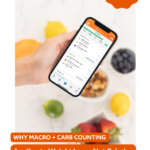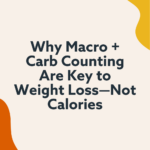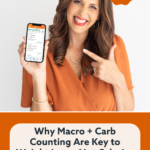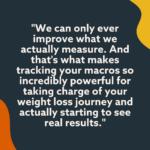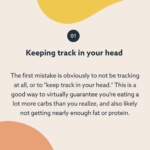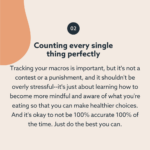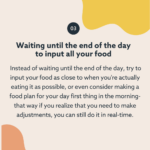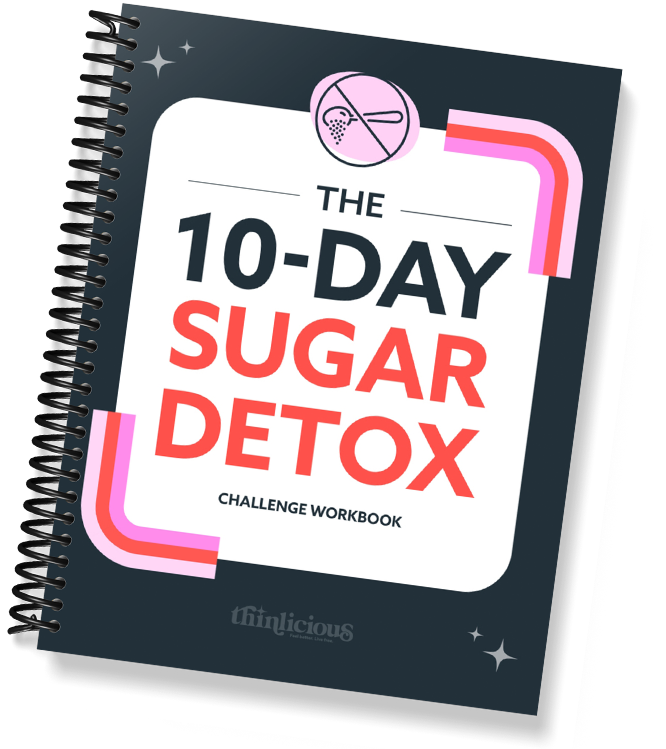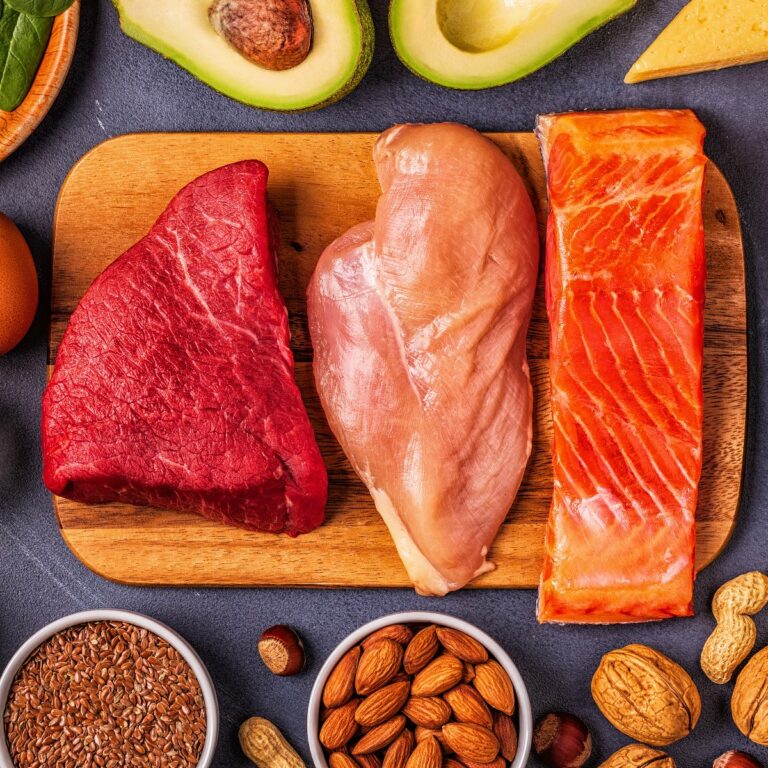What makes carb counting and following a low-carb eating plan so effective when nothing else you’ve ever tried has seemed to work? Is it really possible to lose weight WITHOUT counting calories, restricting how much you eat, or feeling hungry and miserable ALL THE TIME?
Well, the good news is that it’s not only possible but entirely doable!
You’ve probably figured out by now that here at Thinlicious, we’re pretty passionate about ditching the carbs, but what you might not totally understand just yet is WHY….or what that actually means.
So today, we’re going to get super granular and talk about macros and the power of carb counting. We’ll dive into how it works, why it works, and a few pitfalls that can really derail your progress, especially as you are just getting started or if you have hit a plateau.
Are you ready to lose weight and heal your body for life (without dieting, drugs, or making yourself miserable)?
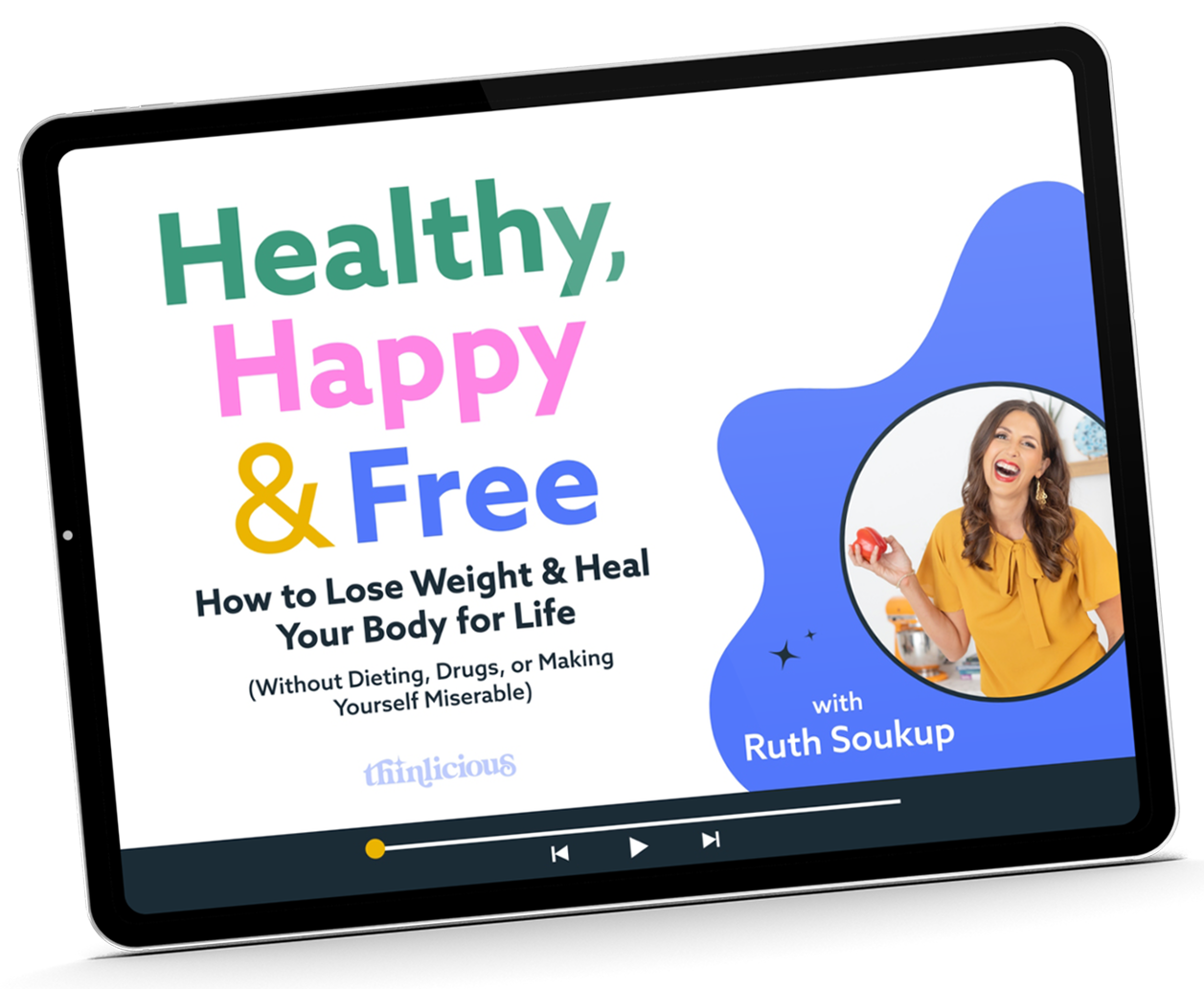
Our free on-demand video training will walk you through how to make this THE year you set health goals…and keep them.

What are macros?
So first things first, let’s talk about macros—what they are and why they matter when it comes to weight loss.
Macros, as you might already know (or at least have heard at some point), is short for macronutrients. This simply means the nutrients your body needs in larger amounts, versus MICROnutrients like vitamins and minerals, which your body needs in very small amounts.
There are 3 macronutrients:
- Proteins
- Carbohydrates
- Fats
What do macros do?
Macronutrients are typically considered essential nutrients, as your body cannot make them or produce enough of them on its own. They contain the components of food that your body needs to maintain its systems and structures. They also provide all the ENERGY your body needs in the form of calories.
Each of these three macronutrients does different things for your body.
Proteins are often referred to as the building blocks of life because they help create and maintain muscle mass.
Carbohydrates provide your body with its primary source of energy, at least in a typical high-carbohydrate diet.
That said, it’s important to understand that your body can use other macronutrients for energy if needed, which really kind of makes carbohydrates a NON essential nutrient.
Fats, on the other hand, are SUPER important for providing essential fatty acids and helping to regulate hormones. Fat often gets such a bad rap, but it really is the thing that keeps your body functioning well, especially as we age and our hormones start to change.
You can read more about macronutrients and what they do here.
How Carb Counting and Macro Tracking Helps with Weight Loss
When it comes to weight loss and getting healthy, all three macronutrients play a vital role. If any one of them is out of balance or lacking in your diet, then it can have an impact on your blood sugar, your metabolism, and your overall energy levels.
While there is no one-size-fits-all approach when it comes to macro ratios, here at Thinlicious, we strongly recommend that anyone looking to lose weight and get healthy focus their efforts on limiting carbohydrate intake. This is because carbohydrates cause the biggest spikes in insulin, which can also lead to fat storage. At the same time, you want to make sure you are getting lots of protein and lots of healthy fats.
Even though “cutting carbs” and going keto has been a pretty popular diet trend for a while now, it feels super counterintuitive for a lot of people.
That’s because most of us grew up in the 80s and 90s, during the fat-free craze.
We were basically told over and over again that fat is bad and that the only way to lose weight is to severely restrict your calories and eat skinless chicken over a bed of lettuce with fat-free dressing.
Yuck, right? No wonder we were so miserable!
Why You Should Focus on Carb Counting, Not Calories
The reality is that your CALORIE count really isn’t the thing that will make a difference when it comes to weight loss.
On a daily basis, even if you are completely sedentary, your body requires a huge number of calories just to maintain its basic functions—far more than most of us ever consume. Despite what “experts” say, weight loss and weight gain are NOT a matter of calories in and calories out.
The truth is that our bodies simply don’t work that way.
Insulin, Not Calories, Is the Problem
So why DO we gain weight and have so much trouble shedding excess pounds? Why does it feel like our metabolism is broken, and why does it sometimes feel like losing weight is IMPOSSIBLE, even when we feel like we’re eating the foods that everyone says are healthy, like fruit and yogurt and oatmeal and whole grains?
It’s usually because if those foods are high in carbohydrates, then we are still spiking our insulin levels and storing more fat than ever.
The single biggest factor in being able to successfully lose weight and keep it off is being able to stabilize your insulin levels.
When your insulin is high, your body stores fat. The standard American diet, which is packed with high-carbohydrate foods, basically just keeps your insulin in a constant state of elevation. Because you’re typically eating more carbohydrates than your body can use for energy, it turns those excess carbohydrates into fat and then tells your body to STORE all that fat.
So every time you eat, you’re turning your body into a fat storage machine without even realizing it.
Read more about how insulin resistance is making you sick and what to do about it here.
What Happens to Your Body When You Start Carb Counting
On the flip side, when you switch to a low-carb diet, start carb counting, and dramatically reduce the number of carbohydrates you are eating, your body is forced to dip into those fat reserves and burn fat for fuel rather than carbs.
That’s because your body NEEDS fat and it NEEDS protein, but it doesn’t actually NEED carbohydrates since it can get fuel for energy from the fat and protein you are consuming.
Become Thin Adapted
The process of switching the way your body burns fuel, from burning carbohydrates as its primary source of energy to burning FAT, is what we call being Thin Adapted.
Honestly, it’s pretty amazing.
Once you are fully Thin Adapted, your body basically has an endless source of energy from the fat reserves in your body. And you feel it. You’re not hungry all the time. You have tons of energy. You’re raring to go. And it’s AWESOME.
The entire goal of carb counting is to help your body make the switch from relying on carbohydrates to burning fat all the time.
How to Find the Right Macronutrients for Your Body
Remember, weight loss is not about counting calories or about restricting what you eat. You don’t have to be hungry. You can basically eat as much as you want or need to feel satisfied. But it has to be the RIGHT foods in the right balance.
So what exactly IS the right balance? Well, at Thinlicious, we have different macro recommendations depending on what phase of our program you are in.
If you’re in Phase 1, which is what we call the ACCLIMATE phase, you want to make sure that your carb counting stays under 25 total grams of carbohydrates per day.
Carbs make up no more than 10% of your total macros, but ideally closer to 5%.
While that is pretty low, you want to make sure you’re getting LOTS of healthy fat. And when I say a lot, I mean a LOT. In Phase 1, 70-80% of your calories should be coming from healthy fats such as:
- avocado oil
- coconut oil
- olive oil
- butter
- full-fat dairy
- fatty cuts of meat
Finally, 15-25% of your macros should be proteins.
Why Carb Counting and Tracking Macros is Crucial
This way of eating can be pretty hard for people when you’re just getting started. This is ESPECIALLY true if you’ve tried to stay away from fat or you’re used to eating a diet that was 80% carbohydrates (typical for most Americans).
It’s a big shift.
And that’s why TRACKING your macros, especially in the beginning, is really, really important.
How to Track Macros
There are lots of different ways to track macros. The easiest way is to use a food tracker app that will calculate your macros and give you a percentage breakdown.
Yes, you can also do this by hand, but you’ll end up having to do a lot of math. It’s really not worth the effort when there are apps that will make it so much easier.
I hope that someday in the future, we’ll have an app that is specifically designed for our program, but for now, we typically recommend using the Lose It App or My Fitness Pal.
Neither are perfect, but both will work and give you the numbers that you are looking for. Remember, you are looking for your total number of carbohydrates, along with your macro ratio breakdown. This is essentially how much of your total calories are coming from carbohydrates, fats and proteins.
While we’re not really concerned about that total calorie number, that is something you’ll also be able to see.
Want more info? This post is all about food trackers and how they work.
Consistency is Key in Macro + Carb Counting
Of course, in order to make this work, you’ll need to input all of the food you are eating throughout the day into the app. Yes, it can sometimes feel a little bit tedious.
I’ve always used the Lose It app, and I do like that it saves your previous meals, so you don’t have to keep re-entering everything, which is especially nice if you tend to eat a lot of the same things.
But it’s still a bit of a pain because you do have to do it every single day, for every meal.
However, it’s more than worth the effort!
Carb counting and tracking your macros are one of the most important things that you can do if you really want to get good results on a low-carb diet plan like Thinlicious. It gives you the ability to see EXACTLY what is working and what isn’t in terms of your macros.
If you are finding that you’re still hungry all the time, or that your energy levels are really low, then you can look at your macro breakdown and start to adjust things.
Maybe you need a little bit more fat, or less carbs. Maybe you need to eat a little more protein. Having those numbers in front of you makes it so much easier to make the changes that you need to get the best results possible.
That being said, a lot of times when people tell me something’s not working and they’re not losing weight or seeing results, it’s often because they aren’t actually tracking at all, and it turns out their ratios were totally off.
How to Read Food Labels
So what should you actually be looking at when it comes to food labels? Which numbers do you need to be paying attention to? What is the difference between net carbs and total carbs? And which of those do you actually need to be worried about?
Serving Size
The first thing you’ll need to look at is the actual serving size.
That is the number that all of the nutrition facts are referring to, so if you eat double what the serving size says, then you’re going to have twice as many carbs and twice as much fat and protein.
Carb Counting for Total vs Net Carbohydrates
For carbohydrates, you want to look at both total carbs and net carbs.
Total carbs refer to the total amount of carbohydrates in a given food item PER SERVING SIZE. This includes things like fiber, allulose, and sugar alcohols.
Net carbs are simply the TOTAL CARBS minus FIBER minus SUGAR ALCOHOLS minus ALLULOSE. You remove those because they don’t actually get digested by your body and don’t typically have an impact on your blood sugar levels or your macros.
For most of the foods you eat you’ll generally want to focus on counting your NET carbs rather than total carbs. This is especially true for natural whole foods such as:
- Fruit
- Vegetables
- Nuts
- Seeds
- Whole grains
- Anything you are cooking from scratch
But it’s a good idea to be a little more careful if you’re eating a lot of processed foods and packaged food items like bars and shakes. Yes, many of them say they are “keto friendly”, because these big multi-national food companies that are just trying to jump on the keto bandwagon.
However, these companies are often trying to game the system by packing their high-carb foods with artificial fiber in order to have a lower “net carb” count.
A few processed items here and there won’t be a big deal and can absolutely be part of a healthy low-carb lifestyle. However, my general rule is to try to focus on filling your diet with as many whole foods as possible.
The less processed, the better!
Protein and Fat
Of course, carbohydrates aren’t the only thing you’ll want to look at on your food labels. Protein and fat are also really important, although they don’t usually get as much attention.
Remember, success with a low-carb eating plan isn’t JUST about keeping your carbs under a certain number. It’s also about hitting the optimal balance of carbs to fat to protein.
So if you’re trying to lose weight on a low-carb plan, then you’ll want to make sure that your protein intake is adequate. This will keep your metabolism running properly and help with satiety. It will also ensure you’re getting enough healthy fats for energy and overall health.
And quite frankly, that’s often where a lot of people go wrong.
4 Common Carb Counting Pitfalls to Avoid
Let’s talk about some of the most common mistakes people tend to make with carb counting and tracking their macros. This way, you know how to avoid them in your own low-carb journey.
1. Not Tracking
The first mistake is obviously to not be tracking at all, or to “keep track in your head.”
This is a good way to virtually guarantee you’re eating a lot more carbs than you realize and also likely not getting nearly enough fat or protein.
2. Stressing Over Tracking
A lot of people get so wrapped up in trying to count every single thing perfectly that they forget to actually ENJOY their food and the journey.
They start to get a lot of anxiety over knowing exact portion sizes, down to the last gram. Yes, tracking your macros is important, but it’s not a contest or a punishment. It shouldn’t be overly stressful—it’s just about learning how to become more mindful and aware of what you’re eating so that you can make healthier choices.
It is okay to not be 100% accurate 100% of the time. Just do the best you can.
3. Waiting Until the End of the Day to Track
A third big mistake is to wait until the end of the day to input all your food, after you’ve already eaten everything. By then, it’s too late to change your plan when you realize you were totally off track.
This is a total recipe for disaster because you won’t be able to go back and adjust the food that you’ve already eaten.
Instead of waiting until the end of the day, try to input your food as close to when you’re actually eating it as possible. You can even consider making a food plan for your day first thing in the morning. That way, if you realize you need to make adjustments, you can still do it in real time.
4. Focusing on Numbers, Not Results
Lastly, I often see people focusing too much on their numbers and not enough on their actual results.
A lot of times, people will get so caught up in trying to hit certain macro targets that they forget that the whole point is actually to get RESULTS.
Are you seeing improvement in your energy levels? In your waistline? In better sleep or digestion? If not, then it might be time to make some adjustments. That could be anything from portion sizes or types of foods to your ratio of carbohydrates to fat and protein.
Make Your Macros Work for You
In the end, it’s important to understand that your health and weight loss journey is yours alone.
Everybody is a little different, which means that what works perfectly for someone else might not be ideal for you.
Plus, what works like a charm for you in the beginning, during phase 1, won’t continue working for you later on as your body becomes Thin Adapted and you’re ready to move into phase 2. That’s why our macro recommendations for Phase 2 of our program are different than in Phase 1.
Ultimately there’s no one-size-fits-all approach to counting macros. It really is about experimenting and finding out what works best for you!
Of course, the best way to see what actually works is to keep track of it. We can only ever improve what we actually measure. And that’s what makes tracking your macros and carb counting so incredibly powerful for taking charge of your weight loss journey and actually seeing real results.
So don’t strive for perfection, but do strive for consistency.
Keep at it. Then start to pay attention to how you feel and what’s working and what’s not. Remember that big goals never happen all at once, but they are the result of small steps taken consistently over time.
So keep it up. Because my friend, you’ve got this!
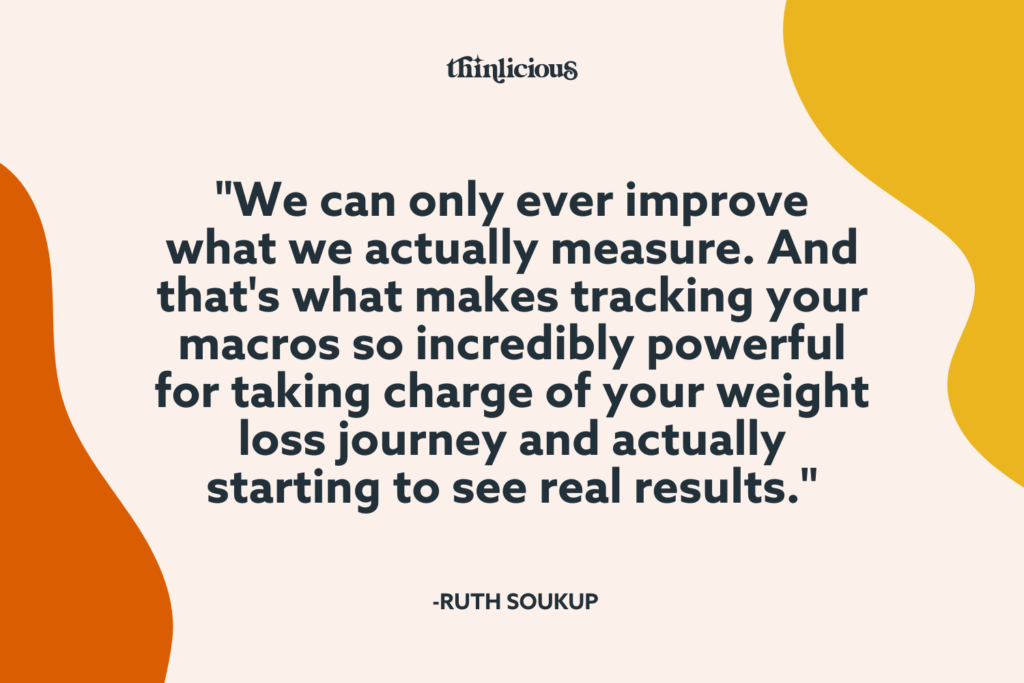
Next Steps
Ready to lose weight and get healthy for life without dieting, drugs or making yourself miserable? Our brand new (and totally free!) on demand video training will help you understand why it’s been so hard and what do to about it.re.
PIN FOR LATER

What if you could actually take control of
your health in just 10 days?
It’s not your fault you can’t lose weight as a woman over 40 even though you’ve likely tried literally everything. Your metabolism probably feels broken and your hormones are likely all out of whack.
But you can fix it all with ONE simple change: eliminate sugar. We make it super easy with daily lessons teaching you the science behind what makes us gain weight in our midlife and beyond! Are you ready to get started now?



